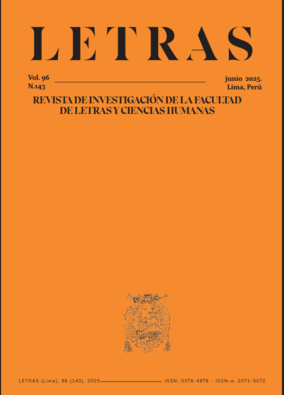Representaciones visuales de una ciudad amazónica contemporánea: reflexiones sobre el ‘espacio fluvial’ iquiteno
Abstract
This article aims to reflect on the nature and usefulness of the concept of “fluvial space.” To do so, it examinescertain contemporary visual representations of the Peruvian Amazonian city of Iquitos. The text argues thatthis concept is particularly appropriate for understanding Amazonian cities by connecting global processesthat structure materialities and spatial practices —alluded to by Henri Lefebvre’s theory of the social productionof space— with particular ecosystems and subjective forms of appropriating space through memory and sensoriality, as implied by the concept of place developed by Tim Creswell. In this endeavor, the article takesas examples two of the most prominent artists of the contemporary Peruvian Amazonian cultural scene —thephotographer Augusto Falconi and the painter Christian Bendayán— and two of their works: “Chauchero cargando hielo” (Chauchero carrying ice, circa 1980), and “Fuerza animal” (Animal Force, 2019). To account forthe complexity of the processes involved in this visual production, the analysis includes three interrelatedcomponents: the researcher’s own interpretation and reaction, the narrative that the artists elaborate on theircompositions, and the cultural and social context of the city in which the artistic representation is imbedded.Downloads
Métricas alternativas
References
Bendayán, C. (2009). Recuerdo de Iquitos. Estruendomudo.
Bendayán, C. (2019). Augusto Falconi. Retrato de Iquitos. En C. Bendayán, R. Rumrrill y R. Rodrich, Augusto Falconi. Fotosociales: retrato de Iquitos 1960-1990 (pp. 19-35). Instituto Cultural Peruano Norteamericano.
Bendayán, C. (2023, julio 13). Entrevistado por G. Castillo Guzmán (Iquitos). Ms.
Bendayán, C. (2023, noviembre 10). Entrevistado por G. Castillo Guzmán (Lima). Ms.
Bendayán, C., Rumrrill, R. y Rodrich, R. (2019). Augusto Falconi. Fotosociales: retrato de Iquitos 1960-1990. Instituto Cultural Peruano Norteamericano.
Blackmore, L. y Gómez, L. (2020). Beyond the Blue. Notes on the Liquid Turn. En L. Blackmore y L. Gómez (Eds.), Liquid Ecologies in Latin American and Caribbean Art (pp. 106-124). Routledge.
Casey, E. (1996). How to get from space to place in a fairly short stretch of time: phenomenological prolegomena. En S. Feld y K. Basso, Senses of place (pp. 13-52). School of American Research Press.
Chirif, A. y Cornejo, M. (2009). Imaginario e imágenes de la época del caucho: los sucesos del Putumayo. Centro Amazónico de Antropología y Aplicación Práctica, International Work Group for Indigenous Affairs, Universidad Peruana de Ciencias.
Creswell, T. (2004). Place: a short introduction. Blackwell.
Falconi, A. (2022, noviembre 3). Entrevistado por G. Castillo Guzmán (Iquitos). Ms.
Falconi, A. (2023, julio 17). Entrevistado por G. Castillo Guzmán (Iquitos). Ms.
Fuller, N. (2001). Masculinidades: cambios y permanencias. Pontificia Universidad Católica del Perú.
García Sánchez, J. y Bernex de Falen, N. (1994). El río que se aleja: cambio del curso del Amazonas. Estudio histórico-técnico. Centro de Estudios Teológicos de la Amazonía, Instituto de Investigaciones de la Amazonía Peruana.
Harvey, D. (1999). The limits to capital. Verso.
Herrera, M. (2023). Comentario a Giuliana Vidarte. Belén como marco para representar la fotografía. En L. Cannock, El arte fotográfico en el Perú. Balance y perspectivas 2018-2020 (pp. 153-162). Pontificia Universidad Católica del Perú, KWY.
Kinney, P. (2017). Walking interviews. Social Research Update 67, 1-22. https://i.org/10.1007/978-981-10-2779-6_28-1
La Serna, J. y Chaumeil, J.-P. (2016). El bosque ilustrado. Diccionario histórico de la fotografía amazónica peruana (1868-1950). Lima: Centro Amazónico de Antropología y Aplicación Práctica, Instituto Francés de Estudios Andinos, CNRS, Centre EREA du LESC, Pontificia Universidad Católica del Perú.
Lefebvre, H. (1991). The production of space. Blackwell.
Lowenthal, D. (1961). Geography, experience, and imagination: towards a geographical epistemology. Annals of the Association of American Geographers 51(3), 241-260. https://doi.org/10.1111/j.1467-8306.1961.tb00377.x
Ortiz, J. (2014). Iquitos: ciudad y puerto en el siglo XIX. En R. Varón Gabai, C. Maza, R. Varón Gabai y C. Maza (Eds.), Iquitos (pp. 22-29). Telefónica.
Oslender, U. (2002). Espacio, lugar y movimientos sociales: hacia una ‘espacialidad de resistencia’. Scripta Nova 6(115). http://www.ub.es/geocrit/sn/sn-115.htm
Panduro, M. (2024). Nunca antes y nunca después. Memorias de Iquitos en siete personajes. Ukamara.
Pretell, B. (2019, noviembre 6). Iquitos monumental: monumentos representativos de la época del caucho. Texto curatorial. https://www.facebook.com/arquitecturaperuana/posts/iquitos-monumental-exposici%C3%B3n-y-conversatoriomonumentos-representativos-de-la-%C3%A9p/2478342329073300/?locale=es_LA
Reátegui, M. (2014). Iquitos: sobre fundaciones y opiniones encontradas. En R. Varón Gabai y C. Maza (Eds.), Iquitos (pp. 30-37). Telefónica.
Relph, E. (2009). A pragmatic sense of place. Environmental and Architectural Phenomenology, 20(3), 24-31.
Rodrich, R. (1996). Entrevista a Augusto Falconí. En C. Bendayán, R. Rumrrill y R. Rodrich, Augusto Falconi. Fotosociales: retrato de Iquitos 1960-1990 (pp. 186-189). Instituto Cultural Peruano Norteamericano.
Rodrich, R. (2019). Entrevista a Augusto Falconí. En C. Bendayán, R. Rumrrill y R. Rodrich, Augusto Falconi. Fotosociales: retrato de Iquitos 1960-1990 (págs. 186-189). Instituto Cultural Peruano Norteamericano.
Rumrrill, R. (2019). Augusto Falconi: el ojo mágico amazónico. En C. Bendayán, R. Rumrrill y R. Rodrich, Augusto Falconi. Fotosociales: retrato de Iquitos 1960-1990 (pp. 13-15). Instituto Cultural Peruano Norteamericano.
Santos Granero, F. y Barclay, F. (2002). La frontera domesticada: historia económica y social de Loreto, 1850-2000. Pontificia Universidad Católica del Perú.
Seamon, D. (2014). Looking at a photograph - André Kertész’s 1928 Meudon: interpreting aesthetic experience phenomenologically. Akademisk, 9, 4-18. https://doi.org/10.5278/ojs.academicquarter.v0i09.3268
Tuan, Y.-F. (2001). Space and place: the perspective of experience. University of Minnesota Press.
Tuuki, E., Jokinen, P. y Kalliola, R. (1996). Migraciones en el río Amazonas en las últimas décadas, sector confluencia ríos Ucayali y Marañón - isla de Iquitos. Folia Amazónica 8(1), 111-130. https://doi.org/10.24841/fa.v8i1.306
Vidarte, G. (2023). Fotografías de Belén. La creación de una tradición paisajística regional y su reinterpretación en el siglo XX. En L. Cannock, El arte fotográfico en el Perú. Balance y perspectivas 2018-2020 (pp. 138-153). Pontificia Universidad Católica del Perú, KWY.
Villar, A. (2014). Los caminos del Edén. Alegorías, selvas y laberintos en la pintura reciente de Christian Bendayán. En C. Bendayán, Bendayán. Crónicas del paraíso. Obra MMXI - MMIV (pp. 25-37). Madriguera.
Copyright (c) 2025 Letras (Lima)

This work is licensed under a Creative Commons Attribution 4.0 International License.
Este obra está bajo una licencia de Creative Commons Reconocimiento 4.0 Internacional



















